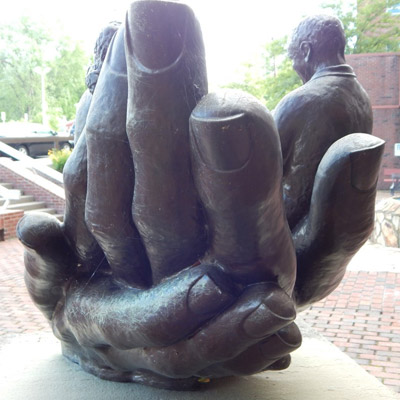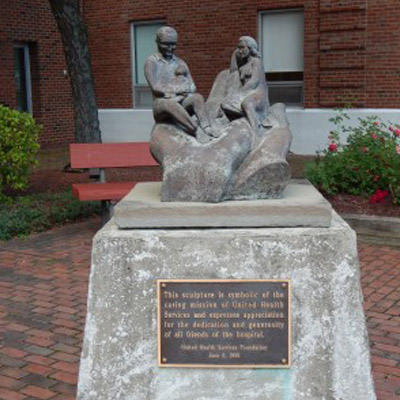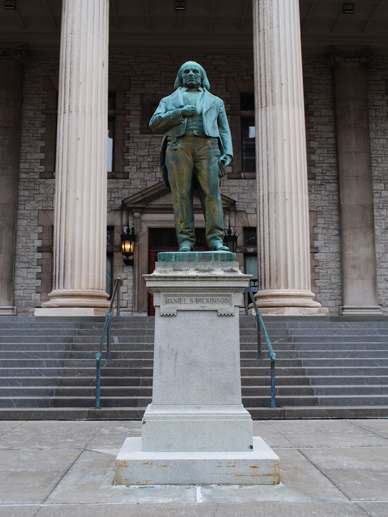Reviewed by George Basler
No one can accuse the KNOW Theatre of coasting into the lazy summer months. Instead, for its final production of the season, the downtown Binghamton theater is staging two one-act plays that seem certain to puzzle, challenge and/or frustrate audiences.
Harold Pinter’s The Dumb Waiter and Edward Albee’s The Zoo Story being presented under the title 4 Actors, 2 Plays, 1 Night. The double bill opened this past weekend (June 14-16) and will run through June 30.
The two works share several points, director Brandt Reiter notes in the production’s program. Both were written in 1959 by authors who were almost exact contemporaries. Both are two-character plays that occur in real time and in a single location. And both are early works that own a clear debt to Samuel Beckett, the Nobel Prize-winning Irish playwright, whom both men admired.
As is routinely the case with KNOW productions, the acting is solid. Under Reiter’s direction, Mike Arcesi, Nick DeLucia, Max Pearson and Tim Gleason all give finely tuned performances. Pearson is especially compelling in the showy role of Jerry in The Zoo Story.
The plays, however, prove the old saying, “One man’s meat is another man’s poison.” Put simply, they are polarizing works. Moreover, as absurdist dramas, they require audience members to do some deep thinking.
This is especially true with Pinter’s The Dumb Waiter. The play walks the fine line between being enigmatic and incomprehensible and too often falls into the latter category.
The plot seems simple enough. The action takes place in a dingy basement room where two veteran hitmen — Ben (Arcesi) and Gus (DeLucia) — are waiting for information on their next job from an unseen boss. While waiting, they engage in mindless chit chat and bickering that takes on a faintly ominous tone as the play progresses.
But nothing is simple with Pinter. The playwright introduces absurdist elements into the realistic setting. High on the list of these elements is the fact that the two hitmen must cope with a constant stream of orders for exotic foods, including a purportedly Greek dish called Ormitha Macarounda. The orders arrive via someone in the building using a dumb waiter. Their frantic efforts to fill the orders create some funny moments.
At the same time, Pinter leaves large gaps in the narrative that audience members are required to fill. More than that, Pinter is pretty darn vague on what it all means.
That may be fine for academics who can sit in their classrooms having esoteric discussions about the obtuse themes in the play. For mere mortals, though, The Dumb Waiter can be an infuriating head-scratcher, featuring two characters who arouse little sympathy.
That’s not the fault of Reiter, who skillfully directs the play so that the action never becomes static despite The Dumb Waiter’s confined setting.
Nor is it the fault of Arcesi and DeLucia, who give solid performances in their roles. DeLucia shows a fine sense of physical comedy as Gus, the more downbeat of the two hitmen. Using facial expressions that veer between bewilderment and moroseness, he successfully shows the character’s growing sense of regret and frustration.
Arcesi gives a well-modulated performance as Ben, who is the alpha dog in the relationship. The performance requires Arcesi to switch from outward calms to hair-triggered anger in an instant, and he does so effectively. The sharp transitions heighten the feeling of unease as the play progresses.
While The Dumb Waiter plays like an intellectual exercise, The Zoo Story has a more visceral emotional kick.
The play focuses on a meeting between Peter, a moderately successful book publishing executive (Gleason), and Jerry, a younger drifter whose isolation is driving him to madness (Pearson). They meet on a bench in Central Park where Jerry begins pouring out the details of his stunted life to a bemused Peter.
The play requires virtuoso performances by both actors. Pearson has the more prominent role as Jerry, and his performance successfully drives the action. What’s most impressive is the restraint that Pearson brings to the role. He never overplays the part by posturing or ranting. Instead he slowly and carefully unveils the character’s mental imbalance. It’s a well-calibrated performance that makes Jerry an almost tragic figure who is longing for connection.
As Peter, Gleason successfully makes the transition from bemusement to animal-like anger when the character snaps at the end of the play after being goaded into rage by Jerry. It’s a powerful and frightening moment that Gleason plays with great proficiency.
As is the case with Pinter, Albee requires audience members to fill in their own answers about what The Zoo Story is about. I’m not even going to try. For me, the play’s attraction lies in how successfully Albee blends mordant humor and melodramatic excess.
Sixty years after its debut The Zoo Story can still shock.
IF YOU GO: 4 Actors, 2 plays, 1 Night will be performed though June 30 at the KNOW Theatre, 74 Carroll St., Binghamton. Performances are 8 p.m. Fridays and Saturdays and 3 p.m. Sundays. Tickets are $15 to $20. For more information, visit knowtheatre.org. This Thursday (June 20) is a pay-what-you-can night.



































